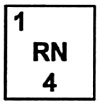
Frank took me to task in TEM 43/44 over my comments on his "Cunningham's Pond" article in TEM 37 and quite properly so. I failed do anything more substantial than cursory research and Frank basically just tacked my hide up on a wall and left it out to cure. I must admit that I figured that the British and Australian official histories would be more than sufficient to analyze any Naval Gunfire (NGF) that the ground forces considered significant. Boy, was I wrong! Frank cites from Rohwer and Hummelchen's Chronology at Sea which I only have access to in the original German and had never looked at. I had no idea that it is such a rich resource for this kind of stuff!
But aside from the research issues there's a difference in how we approach the basic issue of NGF. I tend to focus on the average number of ships on station over two weeks and thus tend to discount actions of very short duration. The NGF provided at Normandy, Anzio, and Salemo is my model where a large number of ships were involved, but relatively few on any given day. This doesn't fit well with what I'd call shore bombardment raids like Bardia or Valona.
Another major difference is that Frank is far more concerned about NGF being strong enough for an odds-column shift than I as his primary concern is the effect on the individual attack. 1, on the other hand, focus more on deriving NGF from the number and size of the ship's guns involved and then translate that into points of NGF since I personally play with odds- rounding where odds-columns are almost irrelevant. Only in this way can I be satisfied that NGF is handled consistently throughout Europa, no matter whether it's the Prinz Eugen in the Baltic or the Inshore Bombardment Squadron because you're often going to have situations that don't readily translate into odd-column shift simply because we don't know enough about the exact ground units involved to do a "Europa as History" analysis that can provide us with the strengths necessary to determine just how much is enough.
I hadn't considered the Luftwaffe to be a factor in determining the availability of Allied NGF, but I think that Frank has hit upon something here since the Brits rarely bombarded anything within range of Luftwaffe close-support aircraft. The two occasions which I can remember that they did so they lost the monitor Terror off Cyrenaica in '41 and a pair of Tribal class destroyers in late '42 near Tripoli. I'll say right now that I'm citing these incidents from memory and could well be wrong before Frank lays into me again.
As a minor point there were only a pair or so of cruisers at any given time on NGF duty during Operation EXPORTER which is how I tend to evaluate things. Ships re-ammunitioning in Haifa while their compatriots are dueling with Vichy super-destroyers and artillery positions are irrelevant as far as I see things.
-
Introduction
Gunfire from the Wine-Dark Sea
Do Frog Legs Taste Better than Crow?
Old Johann Heinrich was an Eisenbahn Mann
Heavy Transports
The Jets Revisited
Back to Europa Number 56 Table of Contents
Back to Europa List of Issues
Back to MagWeb Master Magazine List
© Copyright 1997 by GR/D
This article appears in MagWeb (Magazine Web) on the Internet World Wide Web. Other military history articles and gaming articles are available at http://www.magweb.com